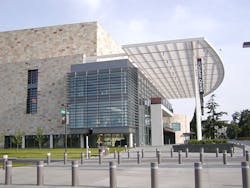University of California campuses cull GHG emissions back to 1990 levels, admit challenges reaching 100% goal
By Rod Walton, EnergyTech Senior Editor
The University of California system’s latest annual report on sustainability trumpets its achievement on reducing greenhouse gas emissions, but cautions there is still much to do.
The UC report said that all campuses and their affiliated health systems have reached the goal of cutting GHG emissions back to 1990 levels. The statewide system reported that energy use intensity has dropped from 175 British thermal units (BTU) per square foot in 2009 to barley over 140 BTU/Sqft in 2020.
This has helped overcome energy demand pressured by the UC system’s growth over the past decades, the report noted. The university is focused on the major challenge of natural gas consumption systemwide.
More than 100 renewable energy projects have been undertaken across the UC campuses and facilities, totaling about 53 MW of clean energy capacity, according to the report.
“Though we have much more work to do, we are proud of this progress toward achieving our ambitious goals around sustainability, climate action and climate justice,” UC President Michael V. Drake, M.D., said in an introduction to the report. “Through our collaboration, creativity and perseverance, we can continue to accelerate UC’s efforts across our research, education and operations, and combat global climate disruption in California and around the world.”
More than 50 percent of UC’s electricity demand is met by renewable or carbon-free resources directly or indirectly, the report noted. The aim, though, is 100 percent by 2025.
2020’s figures, of course, are impacted by onset of the coronavirus pandemic and the move to off-campus learning. The report admits that it remains to be seen if the system can maintain its pace of 2 percent reduction in energy use intensity annually.
Natural gas use is a thorny issue for the University of California system, given both its benefits and environmental detriments. UC invested significantly in gas-fired combined heat and power plants at seven campuses in the 1990s and early 2000s.
“And they’re all still operating, providing relatively low-cost power and resilience during utility power outages,” the report reads.
Eighty percent of UC’s remaining GHG emissions come from on-campus gas-fired energy activities. Completely decarbonizing campus activities while maintain resiliency without those gas-fired CHP plants will be key challenge, the university admitted.
The UC system’s motto has long been “Let there be Light.” The university umbrella includes 10 campuses state-wide educating close to 285,000 students.
-- -- --
(Rod Walton, senior editor for EnergyTech, is a 14-year veteran of covering the energy industry both as a newspaper and trade journalist. He can reached at [email protected]).
